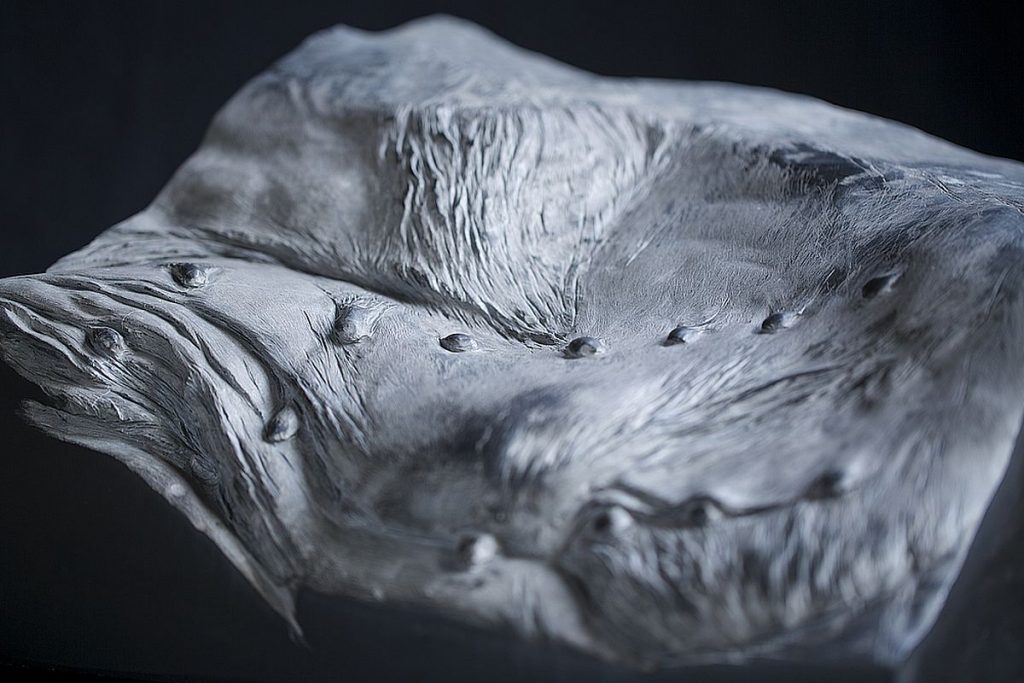
Starting from the flesh and skin, I aim to come to a sculptural abstraction of the perishable bag in which we live. The skin is seen as the separation between the inside of a body and the space around it, the skin itself being shapeless. Being cut loose from the body it brings up a strange objectification with an unheimliches feeling and indefinable sense of misfortune. The living skin constantly renews itself, but with the renewal at a cellular level, beacons of memory are also renewed: a scar, wrinkles, pits and bumps have formed and remain present over the years. At the same time, there is a slow aging process. Cells die and the skin becomes more fragile. Time is present.
My choice to work mainly in stone finds its roots here: the stone is also a carrier of history. The stone with its veins, crystals, fossils, cavities and fractures that folded into shape millions of years ago, determines my artistic work. As an artist you have to surrender to the ‘slowness’ – in our timeframe that is – to engage in a conversation with this ancient material. The black marble I use comes from the quarries in Mazy and is 360 million years old.
The beautiful word ‘Oblivion’ is ‘the state of being completely forgotten or being completely destroyed’. The land of oblivion is equal to death. According to Greek mythology, the lethe was the river of oblivion. It was one of the five rivers in the Greek underworld, the one that flowed through the cave of Hypnos. All dead souls had to drink from his water to experience complete oblivion, the condition to be able to reincarnate.
What I do can be seen as an attempt to overcome ‘oblivion’. Stone sculptures are the gatekeepers of a timeless universe, a universe in which one can observe the decay in slow-motion.

Landscapes constantly change and renew themselves. The remnants of ancient nature phenomena, of changes on the earth’s surface, of animals and plants… are present for a long time and can be read by whoever recognizes them and speaks the language. One can make a comparison with marks on a skin, remnants of life in former times. When I come in a landscape I go looking for these remnants, trying to understand. For me, the beauty of this reading arouses curiosity and softens the awareness of continuous destruction.
In 2016 I spent two weeks on the Faroe Islands where one fairly easily notices the remnants of past ice ages, walking on basalt rocks covered in old lichens. I felt insignificant in this powerful landscape. My time became insignificant. My series ‘Convergenten’ consist of ‘cuts’ in an imaginary landscape, in a parallel universe where the landscape is a body in a timeless space. The title of the series ‘Convergenten’ refers to a biological phenomenon. A convergent evolution is the evolution of the same function in different groups of animals that are otherwise unrelated. For example the wings that developed in bats and in birds. The temporality of the skin weaves itself through timelessness. Time is the phenomenon by which everything that exists, continually plunges into a past from which it never returns.
Throughout my life I have confronted myself with our own temporality, our solitude and struggle with mortality. Being an artist is one possible way to deal with these issues.
Chantal Pollier (1965) lives and works in Ghent (B). As a psychologist and an artist who works in the field of decay and collapse she has a deep interest in the dichotomy between beauty and disgust, in the physical appearance of the gradually disappearing, the beauty of the contemporary in a vulnerable and fragile society, always researching her themes in collaboration with scientists. Her work is exhibited in Belgium and abroad, besides her activities as curator of multiple art-science exhibitions.
https://issuu.com/chantalpollier/docs/pollier_portfolio_research_and_phot
www.chantal-pollier.com
